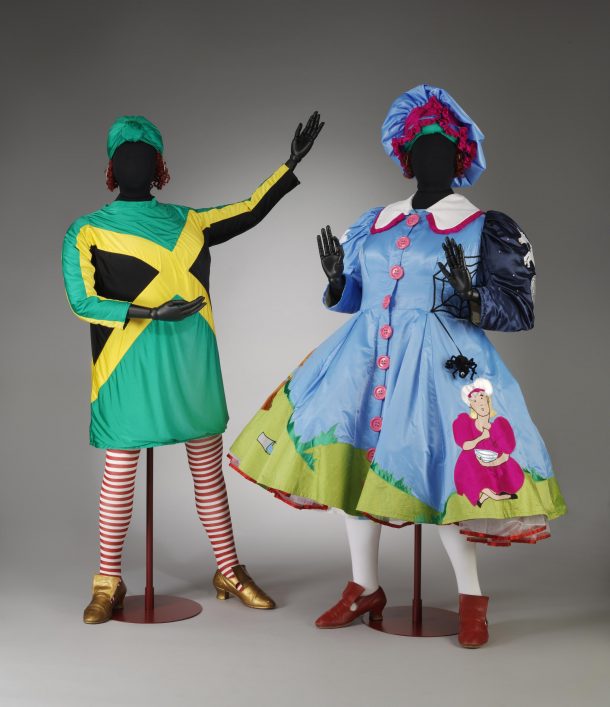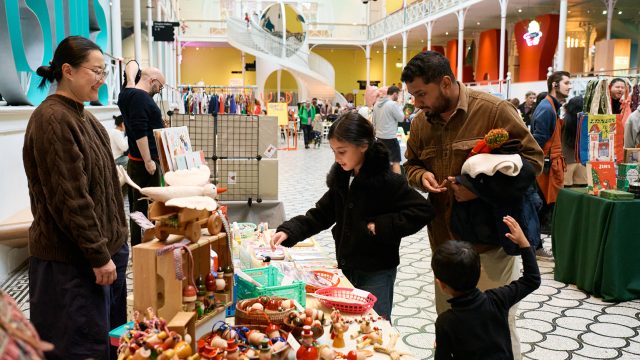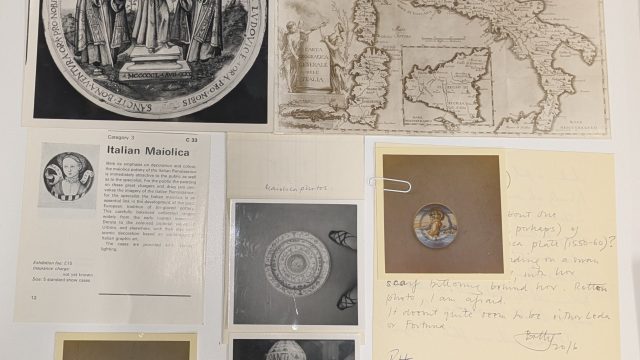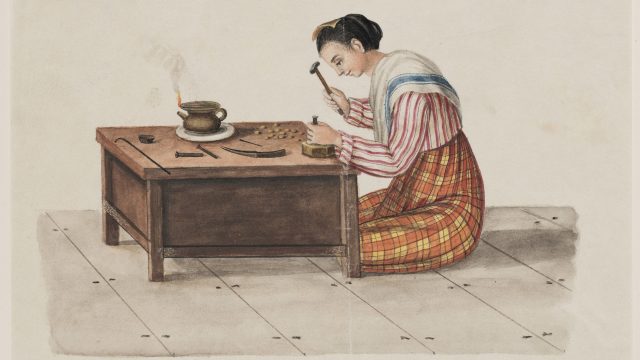Last week many theatres across the UK, facing an unprecedented struggle due to COVID-19, made the devastating decision to cancel much beloved and vital income-generating Christmas pantos. I live in Hackney and grew up here and my first thought was to the Hackney Empire, an architectural gem of London’s theatre world and ‘the best place in London, if not the country’ to see panto according to The Times critic Robert Crampton. Hackney Empire has not yet announced changes to its Christmas programme, but it has, like theatres and live performance venues up and down the country, launched a public appeal to safeguard its future; it is the greatest challenge in their tumultuous 120-year history. My mind also immediately went to works from Hackney Empire’s long history, which are held in the V&A’s collection and which will move to east London when we open V&A East’s new collection and research centre, and museum. Visitors will be able to explore other creative gems from the Hackney Empire alongside thousands of objects, archives and live recordings from the V&A’s theatre and performance collection, which chart the many varied histories of a vast spectrum of live performance past and present, from Shakespeare to Glastonbury via Talawa.

S.10282-2009
The Hackney Empire opened in 1901, and became famous as a music hall where the likes of Charlie Chaplin, Stan Laurel and Julie Andrews all performed; in the 1950s it was used as a tv studio for music programmes such as Oh Boy. In 1984, following decades as a Mecca bingo hall, Clare and Russell Muldoon, founders of the collective socialist theatre group CAST, revived its status as a space for live performance known for its successful alternative comedy programme as well as theatre and mime productions. The Empire was designed by Frank Matcham, a prolific theatre architect who completed over 150 venues throughout his career. For Nicholas Pevsner, the great chronicler of British architecture, the ‘splendid Hackney Empire, with its ornate terracotta exterior and sumptuous 77 galleried auditorium, was one of the best’ surviving examples of this late Victorian- and Edwardian-era purpose-built typology. In 2004, the theatre reopened following a three-year enlargement and renovation project by Tim Ronalds Architects; the most stunning feature of the new exterior is the monumental terracotta and concrete lettering on the facade, made in collaboration with graphic designer Richard Hollis. Cycling past the Hackney Empire every day still gives me an enormous thrill and, as a local, pride in a once much-dismissed and overlooked ‘rough borough’.
The thought that the Hackney Empire’s future might hang in the balance is one of grave concern, not solely because of its history and architecture, but also because of the way it serves its local communities. Like many neighbourhood theatres and arts venues, programming reflects a place and its people. Hackney Empire’s artistic programme is varied across genre and popularity and supporting young people into creative careers is at the centre of its wider mission; thousands of young people have the chance to build skills and networks across all facets of the theatre and performance world and this embedded creative programme is one of the best in the country. But for the youngest in the borough and across east London, a school or family trip to Hackney Empire’s annual pantomime is their first experience of theatre. This is where the magic of theatre first comes to life: a multi-sensory explosion of set, costume, choreography, music, narrative and character. For designer Lotte Collett, who has produced sets and costumes for Hackney Empire pantos since 2004, working with young children in mind is critical:
For very young children, often a panto is their first introduction to the theatre. And in an environment where you’ve got a crowd, you’ve got a fast-paced piece of drama, you’ve got a live band… sensorily, it can be almost too much. So I take it down a peg or two, visually, because making the costumes play brightly against something that is quite washed and pale really makes the characters stand out. And I think it means the child is able to follow the narrative far better, too. – Lotte Collett, Designer
Panto is a cherished British institution and the creative team at the Empire innovatively bring it to life by playing with tradition to make it relevant for local audiences. Director Susie McKenna has written and directed the annual panto since 1998, and staged her last performance there in 2019. The cast, crew and creative team are a family: they mostly live and work in Hackney and this connection to place drives their creative approach. Satirical references in script, costume and set design draw on topical subjects from Brexit and the Windrush generation (see last year’s take on Dick Whittington and his cat) to global sporting heroes such as Jamaican athlete Usain Bolt; music is contemporary, and the cast is ethnically diverse. Discussing the 2018 production of Aladdin, McKenna said:
We have a very diverse cast that reflects Hackney and London. It celebrates community in a way the bigger commercial theatres don’t. All our shows are set in Hackney, whether or not it’s a derivative. This production has all the traditional story – the wicked uncle, the boy dreaming and wishing on a lamp – but it’s set in Ha Ka Ney, which is an Eastern island that’s separated years ago from an Eastern Union and is poor as hell… Yes, that’s a nod to Brexit. I don’t care, I wear my politics on my sleeve. But Hackney is a political place and always has been. – Susie McKenna, Director
Clive Rowe is a Hackney Empire favourite and long-time collaborator with Susie McKenna. He is the only pantomime dame ever nominated for an Olivier Award (Mother Goose in 2009), which is testament to the pivotal role Hackney Empire’s productions have played in garnering critical recognition for this overlooked genre of family entertainment. The V&A holds costumes and drawings by Lotte Collette for Rowe’s dame performance in the 2014 production of Mother Goose. These objects ensure the history of the Hackney Empire’s lauded pantomime productions survive for future generations, enabling us to celebrate their role at the creative vanguard of pantomime as well as share insight into the creative process. Compare, for example, the original drawing for Rowe’s Usain Bolt inspired running suit and the final costume, modified to a dress ensemble to enable a quick costume change demanded by such fast-paced performances. With a new creative team soon to be announced, it will be exciting to see where Hackney Empire takes pantomime in 2020 and beyond.


Hackney Empire is a few miles from east London’s other important theatres and performance spaces: Theatre Royal Stratford East, The Yard, Arcola Theatre and Stratford Circus Arts Centre. Visionary director Joan Littlewood brought the Theatre Royal Stratford East to international acclaim with a radical programme of modern theatre; now under the artistic direction of Nadia Fall, this locally-rooted east London institution continues its progressive programme giving new voices a much-needed platform. The Yard in Hackney Wick is, to quote Time Out London, a ‘beacon of exciting, progressive new work in theatre-poor east London and a real model for what a fringe theatre can and should be in the twenty-first century’. This panoply of diverse theatre culture produces the best of contemporary performance, which help us understand and navigate a complex world. As they all face the biggest challenge in their history, let’s hope the Government’s £1.57 billion injection of arts funding ensures survival for these vital and cherished theatres – here in east London and around the country.


